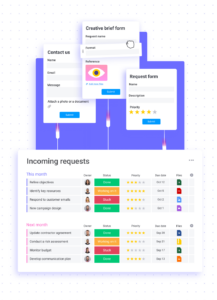Implementing a standardized intake process for creative projects offers several advantages. It eliminates ambiguity by ensuring requests are complete and detailed, reducing back-and-forth communication. Clear processes also enhance project visibility, allowing stakeholders to monitor progress and anticipate deliverables. Ultimately, a well-defined system improves team efficiency and facilitates the delivery of high-quality creative assets on time and within budget.
This article will delve deeper into the practical aspects of establishing and utilizing such a system within Asana, exploring key components like custom fields, project templates, and automation strategies for optimal workflow management. Examples and best practices will be provided to illustrate how organizations can leverage these tools to maximize the effectiveness of their creative teams.
Key Components of a Creative Request System in Asana
Effective management of creative requests necessitates a structured approach. Several key components contribute to a robust system within Asana, ensuring clarity, efficiency, and successful project delivery.
1: Request Forms: Standardized forms ensure consistent information gathering. Required fields capture essential details, minimizing ambiguity and reducing revisions later in the project lifecycle.
2: Custom Fields: Tailored fields within Asana categorize and track specific project attributes, such as due dates, priority levels, target audiences, and required assets. This granular approach facilitates reporting and resource allocation.
3: Project Templates: Pre-built templates streamline project creation, automatically populating tasks, assigning team members, and setting deadlines based on the request type. This reduces setup time and ensures consistency across projects.
4: Approvals: Designated approval steps within the workflow ensure quality control and stakeholder alignment before projects proceed. Clear approval processes prevent misunderstandings and unauthorized work.
5: Automations: Automated rules and workflows trigger actions based on specific criteria, such as assigning tasks upon request submission, notifying stakeholders of updates, or moving projects to different stages upon completion of specific tasks. This streamlines processes and reduces manual intervention.
6: Reporting: Utilizing Asanas reporting capabilities provides insights into project status, team workload, and overall creative output. Data-driven insights enable informed decision-making and resource optimization.
A well-defined system comprising these components allows organizations to effectively manage the intake, execution, and tracking of creative projects, leading to improved team performance and higher-quality deliverables.
How to Create an Asana Creative Request System
Establishing a structured system for managing creative requests within Asana involves several key steps. This process ensures consistent project intake, efficient resource allocation, and streamlined workflows.
1: Define Request Parameters: Determine the essential information required for each request. This includes project titles, descriptions, due dates, target audiences, required assets, and budget considerations. A comprehensive list ensures clarity and reduces ambiguity.
2: Build a Custom Request Form: Utilize Asana’s forms feature to create a structured intake process. Include all defined request parameters as required fields to ensure complete submissions. This form serves as the single point of entry for all creative requests.
3: Establish Custom Fields: Create custom fields within Asana to categorize and track specific project attributes, such as project type, priority level, and relevant stakeholders. These fields enable filtering and reporting, providing valuable project insights.
4: Develop Project Templates: Create project templates for common request types. Pre-populate these templates with standard tasks, assign team members, and set deadlines based on the project scope. This automation saves time and ensures consistency.
5: Implement Approval Workflows: Integrate approval steps within the project workflow to ensure stakeholder alignment and quality control. Designate approvers and establish clear criteria for project sign-off.
6: Configure Automations: Leverage Asana’s automation features to streamline repetitive tasks. Automate actions such as task assignments, notifications, and project stage progression based on specific triggers and criteria.
7: Establish Reporting Mechanisms: Utilize Asana’s reporting capabilities to monitor project progress, track team workload, and analyze creative output. Data-driven insights inform resource allocation and process optimization.
8: Train and Communicate: Ensure all stakeholders understand the new system and its processes. Provide training on how to submit requests, access project information, and utilize the various features within Asana. Clear communication is essential for successful adoption.
By following these steps, organizations can implement a robust system within Asana to manage creative requests efficiently, leading to improved collaboration, increased productivity, and higher-quality deliverables.
A well-structured system for managing creative projects within Asana, built around clear request parameters and robust workflows, provides a crucial framework for successful project delivery. Standardized intake processes, custom fields, and project templates ensure clarity and consistency, while automations and reporting mechanisms enhance efficiency and provide valuable data-driven insights. This systematic approach fosters collaboration, streamlines communication, and ultimately empowers creative teams to deliver high-quality work on time and within budget.
Organizations seeking to optimize their creative workflows and maximize output should prioritize the implementation and ongoing refinement of such a system. A commitment to structured processes, supported by the appropriate technological tools, is essential for navigating the complexities of modern creative project management and achieving sustainable success.

